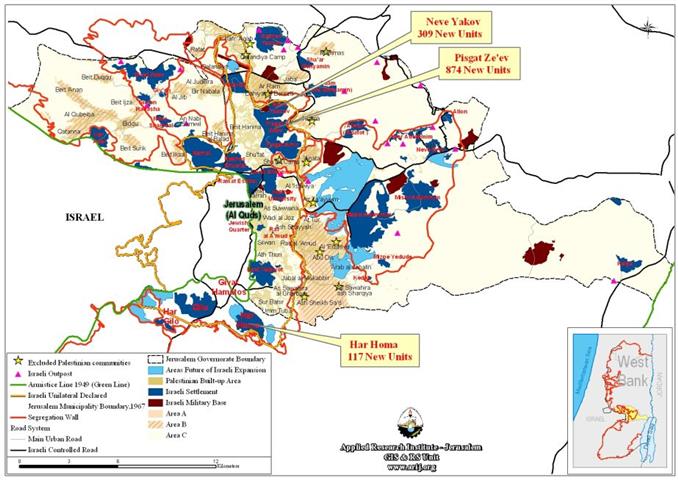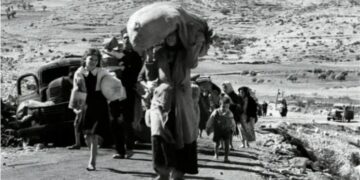Days a after the US Vice President Joe Biden concluded his visit to the region in an attempt to renew the Israeli/Palestinian peace talks, reports were sent out on the continued approvals that the Israeli government and it’s bodies have approved for the process of building and expanding settlements within the occupied territories.
Vice President Joe Biden; ‘I condemn the decision by the government of Israel to advance planning for new housing units in East Jerusalem. The substance and timing of the announcement, particularly with the launching of proximity talks, is precisely the kind of step that undermines the trust we need right now and runs counter to the constructive discussions…..’
The US Secretary of State, Hilary Clinton, criticized Israeli Prime Minister, Benjamin Netanyahu, following the announcement of building 1,600 new housing units in an illegal East Jerusalem settlement as reported
Maannews agency reported that there is a hidden approval of another 1,300 housing units that were approved by the Israeli government but made secret. It was kept secret due to the political mini-crisis that rose due to the disrespectful and provocative decision by the Israeli government to build the 1,600 housing unit in Ramat Shlomo settlement
Neve Yaakov settlement, Building of 309 new housing units
Neve Yaakov, is an Israeli settlement built illegally east of the 1949 Armistice Line (Green Line), within the Israeli unilaterally declared Jerusalem municipal boundary of 1967. Collapsing Israeli governments, and after unilaterally redefining the Jerusalem municipal boundaries in 1971 consider the Neve Yaakov Settlement territory , as part of the neighborhoods of Jerusalem. Neve Yaakov settlement is located north of Jerusalem city and its area totals up to 1,241 dunums. These land were confiscated from three Palestinian communities in East Jerusalem and were allocated for the creation of Nave Yaakov settlement. See Table 1
|
Table 1: Neve Yaakov build-up area on Palestinian villages confiscated lands
|
|
|
Village boundary name
|
Area confiscated in dunum
*(1000 dunums = 1 kilometer square)
|
|
1.
|
Ar Ram
|
102
|
|
2.
|
Beit Hanina
|
634
|
|
3.
|
Hizma
|
504
|
|
|
Total
|
1,241
|
|
Source : ARIJ GIS Unit 2010
|
Today, the settlement of Neve Yaakov houses 20230 Israeli settlers (Israeli Central Bureau of Statistics, 2009).
Har Homa settlement … building of 117 new housing units
Har Homa settlement is located south of Jerusalem city and northeast of Bethlehem governorate. It was established in 1997. Israeli governments, and after unilaterally redefining the Jerusalem municipal boundaries in 1971 consider the Har Homa Settlement territory as part of the neighborhoods of Jerusalem. The settlement is home to 5,000 Israeli settlers (ARIJ Settlemets Database) and occupies a total land area of 2,205 dunums (Table 2) of Bethlehem and Jerusalem governorates.
Har Homa is build on land originally confiscated from Beit Sahour, Bethlehem, Um Tuba, and Sur Baher communities. The area was classified as green area by the Israeli civil administration. Upon that classifications, Palestinians are not allowed to use it for building purposes. By The year 1997, when the Israel government approved the building plan, the area lost most, if not all, its green cover, turning it to a new ‘Jewish only’ settlement. See Table 2
|
Table 2: Village boundaries affected by the establishment of Har Homa
|
|
|
Palestinian Community name
|
Area confiscated in Dunums
|
|
1.
|
Jerusalem
|
859
|
|
2.
|
Bethlehem
|
930
|
|
3.
|
Beit Sahour
|
416
|
|
|
1Dunum = 1000 square meter
Total
|
2,205
|
Source : ARIJ GIS Unit 2010
The declaration of building on the new ‘Jewish only’ settlement of Har Homa in 1997 by Israel, faced harsh criticism by the international community, mainly by the US administration which was leading the peace process.
Press Briefing, White House by Joe Lockhart, November 12, 1998, ‘on that specific issue [building Har Homa settlement], I can say that we are very disappointed by the government’s [Israeli Gov’t] decision on Har Homa. It is inconsistent with the spirit of the Wye agreement and with the need to create a positive atmosphere for permanent status talks. Clearly, this complicates the situation’
Pisgat Ze’ev settlement … Expansion of 874 new housing units
Pisgat Ze’ev ‘Jewish only’ settlement located east of the Green line within the Palestinian Occupied Territories annexed by Israel in 1967 is situated to the North of Jerusalem Governorate. Pisgat Ze’ve houses 48,882 Israeli settlers (CBS – Israel).
Pisgat Ze’ev was built within the illegal, unilaterally declared Jerusalem boundaries by Israel in 1971. The building process in Pisgat Ze’ev started in 1985, on land confiscated from Palestinians. The settlement spreads over a 1,545 dunums of land annexed from two villages’ boundaries. See Table 3
|
Table 3: Village boundaries affected by the building of Pisgat Ze’ve
|
|
|
Village boundary name
|
Area confiscated in Dunum
|
|
1.
|
Beit Hanina
|
1,379
|
|
2.
|
Hizma
|
148
|
|
|
1 Dunum = 1000 square meter
Total
|
1,545
|
Source : ARIJ GIS Unit 2010
The building of the Segregation Wall in Jerusalem Governate will assure the annexation of those areas to the unilaterally declared Jerusalem boundaries delivering the Israeli prolonged plan of ‘Greater Jerusalem’
. This annexation will deprive Palestinian Jerusalemite from accessing their lands and holy places located in the governorate boundaries and create a de-facto status of canonized Palestinian communities surrounded by walls and settlements
. Table 4
The Israeli Segregation Wall around Jerusalem will impound the future development of 12 Palestinian localities, while its route will assure the including major settlements blocs to be annexed to the unilateral boundaries de-facto status, thus imposing the Greater Jerusalem plan.
|
Table 4: Palestinian Communities affected by the Segregation Wall in East Jerusalem.
|
|
Population
|
Palestinian Communities
|
|
26,730
|
Al Ram & Dahiyat Al Bareed
|
|
2,768
|
Az ‘Ayyem
|
|
6,367
|
Hizma
|
|
10,248
|
‘Anata
|
|
11,820
|
Shu’fat Refugee Camp
|
|
5,641
|
Al Sawahereh Al Sharqieh
|
|
2,513
|
Al Sheikh Sa’d
|
|
18,170
|
Al Eizariya
|
|
9,750
|
Qalandyia Refugee Camp
|
|
10,873
|
Kafr ‘Aqab
|
|
1,962
|
Mikhmas
|
|
12,648
|
Abu Dis
|
|
119,490
|
Total
|
Source : ARIJ Data Base 2010
Expanding and building new settlements within the occupied Palestinian territories have been regarded as the key obstacle in the prolonged journey of peace. Nevertheless, Israel has ignored the international community pressure on this issue, downplaying its influence on the peace process led by the international community.
The International community, concerning illegal Israeli expansions of settlements in occupied East Jerusalem:
The Israeli decision for the illegal settlement expansions in East Jerusalem, faced harsh direct criticism by the international community. It has been mostly labeled as a unilateral de-facto policy applied by Israel that is undermining the stability in the Mideast, creating more obstacles in the path of the Palestinian Israeli peace process. The following are statements set by the key stakeholders of the Israeli Palestinian peace process:
-
US : White House Statement by Vice President Joe Biden; ‘I condemn the decision by the government of Israel to advance planning for new housing units in East Jerusalem. The substance and timing of the announcement, particularly with the launching of proximity talks, is precisely the kind of step that undermines the trust we need right now and runs counter to the constructive discussions that I’ve had here in Israel.
We must build an atmosphere to support negotiations, not complicate them. This announcement underscores the need to get negotiations under way that can resolve all the outstanding issues of the conflict. The United States recognizes that Jerusalem is a deeply important issue for Israelis and Palestinians and for Jews, Muslims and Christians’.
EU:Declaration by Catherine Ashton, the High Representative of the EU for Foreign Affairs and Security Policy; The European Union condemns the recent decision of the Israeli authorities to authorize construction around the Shepherd Hotel in East Jerusalem. The international community is making every effort to facilitate the resumption of peace talks. Settlement construction in East Jerusalem is illegal and undermines these efforts. The EU calls on Israel to reverse this decision.
Quartet: The Quartet condemns Israel’s decision to advance planning for new housing units in East Jerusalem. The Quartet has agreed to closely monitor developments in Jerusalem and to keep under consideration additional steps that may be required to address the situation on the ground.
The Quartet re-affirms that unilateral actions taken by either party cannot prejudge the outcome of negotiations and will not be recognized by the international community.
Not only does Israel;s recent behavior contradict the will of the international community, but it is in contradiction with international law, human rights treaties and multiple UN Security Resolutions such as 237, 271, 446, 452, 465, 476, 478, 592, 605, 607, 636, 672, 694, 726, 799, 904, 1073, 1322.
All resolutions formerly mentioned are UN Security Council Resolutions affirming that the status of Jerusalem is approached as an occupied territory demanding the Israeli government to apply international law in its practices in this territory, which Affirms the applicability of the fourth Geneva Convention to Jerusalem.
UN Resolution 446 March 22, 1979 calls on Israel to rescind its previous measures and to desist from taking any action which would result in changing the legal status and geographical nature and materially affecting the demographic composition of the Arab territories occupied since 1967, including Jerusalem and, in particular, not to transfer parts of its own civilian population into the occupied Arab territories’.
UN Resolution 452 of 1979; “calls upon the Government and people of Israel to cease, on an urgent basis, the establishment, construction and planning of settlements in the Arab territories occupied since 1967, including Jerusalem”
Furthermore, in May 2001, the head of the International Red Cross delegation to Israel and the Occupied Territories said that settlements are ‘equal in principle to war crimes’.
Note: ‘The transfer, the installation of population of the occupying power into the occupied territories is considered as an illegal move and qualified as a ‘grave breach.’ It’s a grave breach, formally speaking, but grave breaches are equal in principle to war crimes’, Rene Kosirnik, head of the ICRC delegation to Israel and the OPT.
::::::::::::::____
[1] Statement by Vice President Joe Biden
[6] Statement by Vice President Joe Biden
http://www.whitehouse.gov/the-press-office/statement-vice-president-joseph-r-biden-jr
[7] Catherine Ashton, the High Representative of the EU for Foreign Affairs and Security Policy
http://www.consilium.europa.eu/uedocs/cms_Data/docs/pressdata/EN/foraff/113542.pdf
Prepared by:













